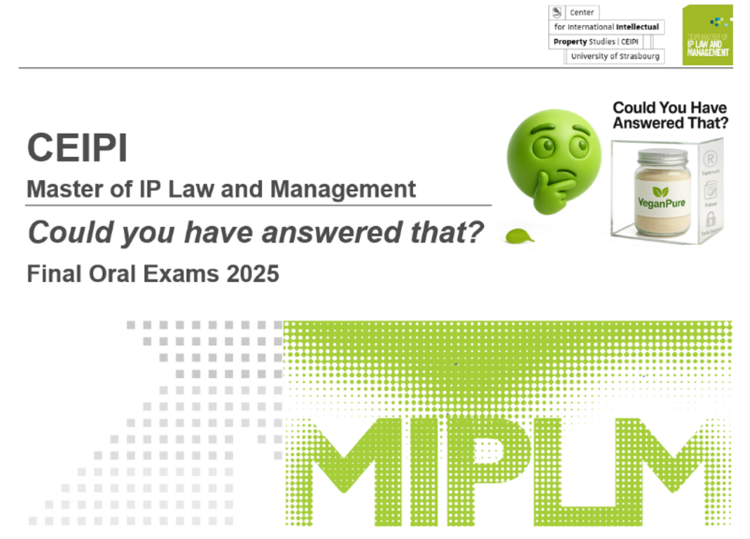Could You Have Answered That? — CEIPI MIPLM 2025
Task 18: Ingredient Branding and Monopoly-in-a-Box
In the final oral exam of the CEIPI Master Program in Intellectual Property Law and Management (MIPLM) 2025, students are once again tested on their ability to connect IP law with practical business management. One of this year’s tasks, Task 18, focused on ingredient branding — a textbook case for applying strategic IP thinking to real market situations.
Here you can find the background to the academic training programs in IP Management:
👉 https://ipbusinessacademy.org/ip-managment-at-ceipi
The Exam Question: What Was Asked?
Scenario:
The fictional company NutriSource Pro supplies high-quality natural ingredients to the food and beverage industry, focusing on vegan consumers. Its goal: create an ingredient brand — a branded, recognizable ingredient that enhances the appeal of end products through co-branding partnerships with innovative food brands.
Your Role:
As the IP consultant, you must develop an IP strategy that:
- Supports ingredient branding as a marketing concept.
- Builds a monopoly-in-a-box with a well-defined portfolio, strong technology coverage, and enforceable rights.
- Enables commercial exploitation through entry licensing.
In other words, the examiner expects candidates to transform a commodity ingredient into a branded, protectable asset that creates consumer pull and business leverage.
What the Lectures Teach: Strategic Management Meets IP
If you prepared with the slides from Prof. Dr. Alexander J. Wurzer’s M1-2 IP Strategy Development module, you know this question connects directly to several core ideas:
1 . Strategy Is About Creating Sustainable Competitive Advantage
As the lecture reminds us, strategy is more than planning — it’s about winning. This means turning IP into a shield (barrier to entry), a sword (market power) and a lever (value extraction). The resource-based view teaches us to focus on the firm’s unique resources — here, the ingredient’s special qualities, proprietary processing, and the brand built around them.
2 . Industry and Competitive Analysis Shape IP Decisions
The slides explain how Porter’s Five Forces help analyze threats and opportunities. For ingredient branding:
- Bargaining Power of Buyers: Branded ingredients shift power back to the supplier by adding non-substitutable value.
- Threat of Substitutes: Protecting unique taste profiles and qualities reduces substitutability.
- Rivalry: Branding and IP fences limit new competitors.
- Suppliers and Entrants: Licensing or partnerships control supply and market entry.
3 . The “Monopoly-in-a-Box” Concept
The lectures emphasize that successful IP strategy builds appropriable market power. This means bundling:
- Patents (protecting processing methods, extraction techniques, unique formulations).
- Trademarks (the ingredient brand itself).
- Design rights or trade dress (for packaging).
- Trade secrets (sourcing, recipes, supply chain know-how).
Together, these form a “box” that competitors can’t easily copy.
4 . Exploitation: Licensing as the Revenue Engine
NutriSource Pro should not only supply ingredients but license its branded name to food producers. Think of Intel Inside — every PC maker paid to put that sticker on laptops. The lectures show how licensing turns IP from a legal cost into a revenue source.
Relevant IP Business Academy Experts
On the IP Business Academy platform, multiple IP subject matter experts share practical content directly linked to this topic. For example:
- Nina Kolar: How IP Shapes Branding, Marketing, Advertising, Packaging, and Franchising
- Bernd Bösherz: Industry Acumen for Patent Attorneys
- Prof. Waldemar Pfoertsch: Ingredient Branding Strategy and Practice
- Prof. Kelvin Willoughby: Intellectual Property in Co-Creation
Learners can find deep dives, articles, and even webinars on:
- How Ingredient Branding Builds Powerful B2B and B2C Market Value
- Layered IP Strategy
- Unique Selling Proposition (USP)
Sample Solution: A Generic IP Strategy for NutriSource Pro
So how should a candidate answer?
Below is a structured approach combining the MIPLM lectures, best practices and real examples:
1 . Define the Core IP Objectives
Key goal: Create a differentiated, recognized ingredient that cannot easily be copied — and that adds unique marketing value to partners’ products.
The strategy must:
- Build consumer trust in the ingredient’s vegan quality and unique properties.
- Ensure exclusivity through enforceable rights.
- Enable scalable use through entry licensing to food brands.
2 . Build a Well-Defined IP Portfolio
A. Patents:
Protect unique extraction methods, formulations, or functional characteristics that deliver taste or nutritional benefits. For example, a patented cold-extraction technique that preserves nutrients for plant-based proteins.
B. Trade Secrets:
Keep critical parts of processing confidential (e.g., sourcing networks, exact blending ratios). Protect these with robust NDAs for partners and suppliers.
C. Trademarks:
Register a clear, memorable ingredient brand. Consider:
-
- Word mark for the brand name.
- Logo mark for visual branding.
- Certification marks for vegan standards if relevant.
D. Design Rights / Trade Dress:
If the ingredient is supplied in consumer-visible packaging (like sachets for co-branding), protect the distinctive look.
3 . Combine Branding with Enforcement — the Monopoly-in-a-Box
Example: Intel Inside
Intel used trademarks, advertising and licensing to ensure that PC makers proudly advertised Intel’s chips. The same applies for NutriSource Pro:
- Co-Branding: Require partners to display NutriSource VeganPure on packaging.
- Quality Control: License agreements should specify usage rules to maintain brand reputation.
- Technology Fencing: Patents and trade secrets ensure no competitor can offer the same taste or benefit.
This “box” of patents, trade secrets, and trademarks together creates the barrier to entry and the platform for premium pricing.
4 . Exploit the IP Portfolio Through Licensing
Licensing is the bridge from protection to profit. The strategy should include:
- Entry licenses for food brands to use the ingredient and display the ingredient brand.
- Royalty structure linked to volume or market share.
- Tiered agreements: higher-tier partners get marketing support or co-developed products.
Example:
A vegan ice cream producer licenses NutriSource VeganPure to co-brand its new line. The ice cream packaging highlights the ingredient, boosting credibility among vegan consumers.
5 . Secure Value Across the Value Chain
To strengthen bargaining power:
- Negotiate exclusivity in certain segments (e.g., only this vegan yogurt uses VeganPure).
- Bundle supply contracts with IP licenses — buyers pay not just for raw ingredients but for the brand premium.
- Use trademark enforcement to prevent misuse or dilution.
6 . Monitor and Enforce
A robust IP strategy includes clear enforcement. The company must:
- Regularly watch for copycats.
- Take action against unauthorized use.
- Train partners on brand usage.
7 . Align with Industry Trends
Vegan consumers care about sustainability and transparency. IP can support this:
- Certification marks prove compliance.
- QR codes linked to trademarked brand pages can show sourcing and processing, building trust.
Practical Tip: Avoid Common Pitfalls
The lectures stress that weak portfolios lead to monopoly illusions. Common mistakes to avoid:
- Only registering a trademark but ignoring patents or trade secrets.
- Failing to enforce brand standards, leading to dilution.
- Over-promising in co-branding deals but not controlling usage.
Could You Have Answered That?
Ingredient branding shows how modern IP strategy works at its best: turning technical know-how and marketing into a sustainable competitive advantage.
For future MIPLM students and professionals alike, the lesson is clear: don’t just protect — position, brand, and license.
If you want to train this approach, the IP Business Academy offers webinars, real case studies, and in-depth lectures from the very IP Subject Matter Experts who shape these best practices in real companies.
You can find more information about our academic education programs at:
👉 https://ipbusinessacademy.org/ip-managment-at-ceipi
and information on our new MBA double degree program with HHL at:



